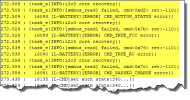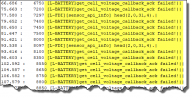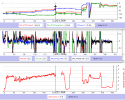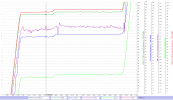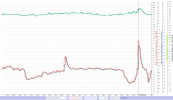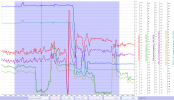But the drone keeps behaving erratically until 270sec into the flight.The incident abruptly goes back to normal at approx 220sec when the IMU (1) (red graph) quickly adjust itself with 35 degrees ... which then goes back to agreeing with the presumed correct showing compass.
It is extremely strange that while the drone was over water it has behaving erratically, then at 270sec I push the stick forward, it flies over land and the issue stops immediately!
I didn't see the yaw change immediately because for some reason the gimbal decided to stabilize the yaw and keep looking at the same place it did before the yaw change, now the gimbal was pointing diagonally to the left. Then, when I looked at the drone, I saw it was drifting towards the right and rotating slowly.First ... you said you saw the drift & the rapid yaw change, this indicate that the movements really happened as the unused IMU (0), the compass & the gyro claims in the log.
After that, I tried to stabilize the drone using the sticks, visually looking at it, not the screen. I brought it back a bit to where it was, but the gimbal kept pointing diagonally, and the drone kind of stabilized for a few seconds (4 or 5 secs) and then got even more unstable, it started going left to right pretty fast and abruptly, and the movement got even weirder when I tried to stabilize that with the sticks. I got confused & scared that it might fail, flyaway, or just fall into the water at that point, and decided to push forward and bring it towards land. In the video, during that moment, a propeller is visible in the top left of the screen, showing that the gimbal was not pointing straight. As soon as it was over land (over the rocks & sand, close to the takeoff location) the strange movement and behavior stopped immediately, the gimbal pointed straight again, and the drone behaved as it should.
Last edited:



